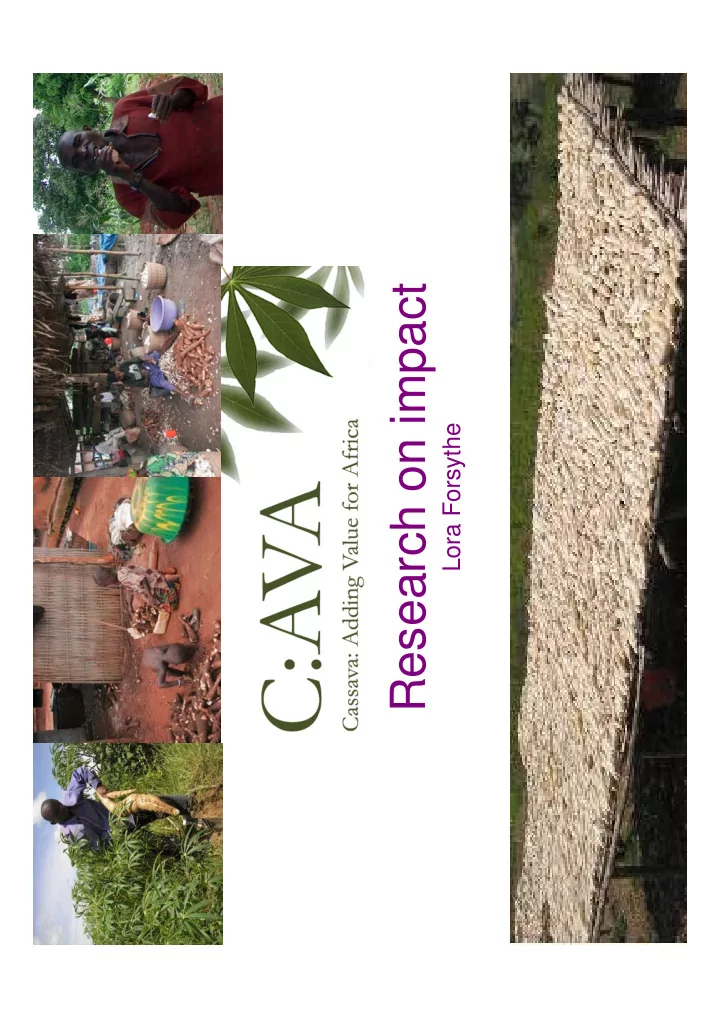

Research on impact Lora Forsythe
Q: What are the impacts of staple crop commercialisation on the livelihoods of small ‐ scale farmers? • Help understand how markets can be made to work of the poor • Emphasising changes in gender relations and household food security • Malawi and Nigeria selected as case studies • Analysis of changes to livelihood assets and livelihood strategies of small ‐ scale farmers and processors • Methods: literature review, 2010 initial focus groups, 2011/12 household interviews for decision making and start of changes, 2012/13 household interviews for final impact
DfID livelihood framework
• Livelihood assets/strategies determined which value chains beneficiaries participated in • Value chain Livelihood participation Assets determined change in livelihood assets/strategies Value chain participation
Influential factors on value chain participation • Profit and food security • Credit availability ‐ linked to social capital • Fuel price – determine which markets and where • Market associations/marketing caps • Labour availability – linked to social capital • Beliefs and perceptions of work • Consumption preferences • Processing and selling location • Pace at which product is sold • Perishability/food security • Networks and quality of product – can test gari immediately
Nigeria ‐ production changes • Increase in productivity through new varieties, but not in all locations • Expansion of cassava production (1 ‐ 5 acre approx) • Some communities complained that the canopy size of the plant had reduced increasing susceptibility to sun • Distribution in some areas was problematic – i.e. farmers not passing on stems – communities with tense relationships and history of political favouritism • Reduction in hiring labour for weeding (1000 ‐ 2000N to clear 1ha opposed to 5000 ‐ 6000N manually) or time for weeding (particularly for children and women)!
Nigeria: processing changes • Most processing gari and fufu paste • Differences in perceptions of the fufu market • Market price and demand seems to be improving in some areas • Processing facilities unhygienic on appearance – poor drainage, animals • Some areas where associations prevent people entering into fufu (outside Akure) • Credit availability a constraint on increasing production • Roots available but price often too high
Malawi • Increased sale and income through new opportunities • High expectations leading to some impatience • One example where processor entrepreneurs/producers couldn’t agree on price • Wheat flour sold 180 to 220k in some areas ‐ making HQCF very affordable and great for rural bakers! • Greater production and processing activities; however, some were still selling old stock • Number of hired labourers increased
Case study: Malawi Mrs. Liwa Mr. Chikaonda Mrs. Zyoli Sell large amounts Processing Makes more profit quickly equipment =120kw/wk (200) Reduced time Sept 2011 “They admire my weeding, kandolie mandazis. They fill 15kq HQCF sold per the stomach” 100 kg x 10kw (7) week x 80 kw Wants to start a Spent on food 4 staff employed (3 clothing business women peelers) Additional income to men’s fishing
Food security Nigeria Malawi • Improvement in the past ten years • Improvement in the past ten years • Greater number of food insecure • Commercially oriented and greater situations diversity in diet • Prioritised food storage and food • Crops used for saving/buffer (kola budgeting over market nut, cassava, palm etc) participation • HH less food security more involved • Staple crops used for food security in gari because due to storage and minor crops would assist with potential – propensity for taking income generation risk is lower • Unequal relations in the hh causing food insecurity in some cases • Very few examples of market participation causing food • Bitter vs sweet ‐ something to watch insecurity – except in the cases of • Preferred HQCF to sell quickly severe hh power imbalances • Service provider approaches influenced outcomes
Gender • Increase in processing opportunities empowering women in some cases, but there were other cases causing tension Increase in male participation with fufu processing and greater • control over processing equipment • Reduction in time weeding Women couldn’t exploit new opportunities due to lack of control • over their labour • Nigeria: Fufu a healthy alternative to gari, preferred location and involved less travel (in some cases) Malawi: women preferred one ‐ day processing • • Women’s access to own plots gave greater control over budgeting decisions, cost of production and access to income Use of cassava peels •
CAVA intervention • Sustainability • Routes of value chain participation • Impact To do: ‐ PhD!! ‐ C:AVA papers on impact, gender and food security
Adrienne Martin Natural Resources Institute Tel: +44 1634 883055 University of Greenwich Email: A.M.Martin@gre.ac.uk Central Avenue, Chatham Maritime Kent, UK ME4 4TB Lora Forsythe THANK YOU Tel: +44 1634 883067 Web: www.nri.org Email: l.forsythe@gre.ac.uk Fax: +44 1634 883377
Recommend
More recommend